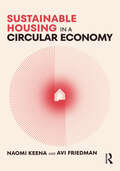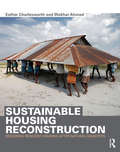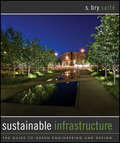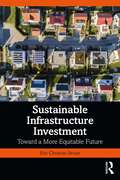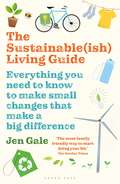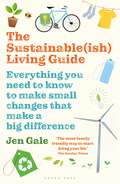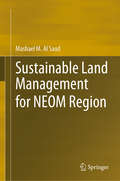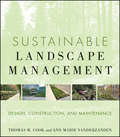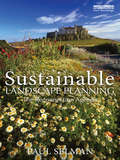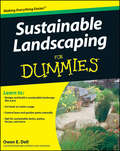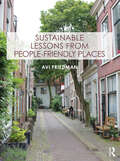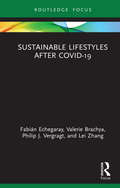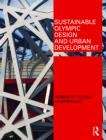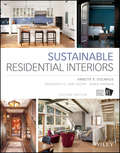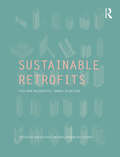- Table View
- List View
Sustainable Housing in a Circular Economy
by Naomi Keena Avi FriedmanThis book relates circular economy principles to housing design and construction and highlights how those principles can result in both monetary savings, positive environmental impact, and socio-ecological change.Chapters focus on three key circular economy principles and apply them to architectural construction and design, namely rethinking of the end-of-use phase of a building and the potential of design-for-disassembly; the role of digitization and data standardization in fostering evidence-based circular economy design decision-making; and presenting space as a resource to conserve, via exploration of the sharing economy and flexibility principles. Beyond waste management and material cycles, this book provides a holistic understanding of the opportunities across the building life cycle that can allow for sustainable and affordable circular housing. With case studies from 13 different countries, including but not limited to the Hammarby Sjöstad district in Sweden, the Circle House in Denmark, Benny Farm in Canada, VMD Prefabricated House in Mexico, and the Deep Performance Dwelling in China, authors pair theoretical frameworks with real-world examples.This will be a useful resource for upper-level students and academics of architecture, construction, and planning, especially those studying and researching housing design, building technology, green project management, and environmental design.
Sustainable Housing in a Circular Economy
by Naomi Keena Avi FriedmanThis book relates circular economy principles to housing design and construction and highlights how those principles can result in both monetary savings, positive environmental impact, and socio-ecological change.Chapters focus on three key circular economy principles and apply them to architectural construction and design, namely rethinking of the end-of-use phase of a building and the potential of design-for-disassembly; the role of digitization and data standardization in fostering evidence-based circular economy design decision-making; and presenting space as a resource to conserve, via exploration of the sharing economy and flexibility principles. Beyond waste management and material cycles, this book provides a holistic understanding of the opportunities across the building life cycle that can allow for sustainable and affordable circular housing. With case studies from 13 different countries, including but not limited to the Hammarby Sjöstad district in Sweden, the Circle House in Denmark, Benny Farm in Canada, VMD Prefabricated House in Mexico, and the Deep Performance Dwelling in China, authors pair theoretical frameworks with real-world examples.This will be a useful resource for upper-level students and academics of architecture, construction, and planning, especially those studying and researching housing design, building technology, green project management, and environmental design.
Sustainable Housing Reconstruction: Designing resilient housing after natural disasters
by Esther Charlesworth Iftekhar AhmedThrough 12 case studies from Australia, Bangladesh, Haiti, Sri Lanka, Vietnam and the USA, this book focuses on the housing reconstruction process after an earthquake, tsunami, cyclone, flood or fire. Design of post-disaster housing is not simply replacing the destroyed house but, as these case studies highlight, a means to not only build a safer house but also a more resilient community; not to simply return to the same condition as before the disaster, but an opportunity for building back better. The book explores two main themes: Housing reconstruction is most successful when involving the users in the design and construction process Housing reconstruction is most effective when it is integrated with community infrastructure, services and the means to create real livelihoods. The case studies included in this book highlight work completed by different agencies and built environment professionals in diverse disaster-affected contexts. With a global acceleration of natural disasters, often linked to accelerating climate change, there is a critical demand for robust housing solutions for vulnerable communities. This book provides professionals, policy makers and community stakeholders working in the international development and disaster risk management sectors, with an evidence-based exploration of how to add real value through the design process in housing reconstruction. Herein then, the knowledge we need to build, an approach to improve our processes, a window to understanding the complex domain of post-disaster housing reconstruction.
Sustainable Housing Reconstruction: Designing resilient housing after natural disasters
by Esther Charlesworth Iftekhar AhmedThrough 12 case studies from Australia, Bangladesh, Haiti, Sri Lanka, Vietnam and the USA, this book focuses on the housing reconstruction process after an earthquake, tsunami, cyclone, flood or fire. Design of post-disaster housing is not simply replacing the destroyed house but, as these case studies highlight, a means to not only build a safer house but also a more resilient community; not to simply return to the same condition as before the disaster, but an opportunity for building back better. The book explores two main themes: Housing reconstruction is most successful when involving the users in the design and construction process Housing reconstruction is most effective when it is integrated with community infrastructure, services and the means to create real livelihoods. The case studies included in this book highlight work completed by different agencies and built environment professionals in diverse disaster-affected contexts. With a global acceleration of natural disasters, often linked to accelerating climate change, there is a critical demand for robust housing solutions for vulnerable communities. This book provides professionals, policy makers and community stakeholders working in the international development and disaster risk management sectors, with an evidence-based exploration of how to add real value through the design process in housing reconstruction. Herein then, the knowledge we need to build, an approach to improve our processes, a window to understanding the complex domain of post-disaster housing reconstruction.
Sustainable Infrastructure: The Guide to Green Engineering and Design
by S. Bry SarteAs more factors, perspectives, and metrics are incorporated into the planning and building process, the roles of engineers and designers are increasingly being fused together. Sustainable Infrastructure explores this trend with in-depth look at sustainable engineering practices in an urban design as it involves watershed master-planning, green building, optimizing water reuse, reclaiming urban spaces, green streets initiatives, and sustainable master-planning. This complete guide provides guidance on the role creative thinking and collaborative team-building play in meeting solutions needed to affect a sustainable transformation of the built environment.
Sustainable Infrastructure: The Guide to Green Engineering and Design
by S. Bry SarteAs more factors, perspectives, and metrics are incorporated into the planning and building process, the roles of engineers and designers are increasingly being fused together. Sustainable Infrastructure explores this trend with in-depth look at sustainable engineering practices in an urban design as it involves watershed master-planning, green building, optimizing water reuse, reclaiming urban spaces, green streets initiatives, and sustainable master-planning. This complete guide provides guidance on the role creative thinking and collaborative team-building play in meeting solutions needed to affect a sustainable transformation of the built environment.
Sustainable Infrastructure Investment: Toward a More Equitable Future
by Eric Christian BruunThis book provides examples and suggestions for readers to understand how public investment decisions for sustainable infrastructure are made. Through detailed analysis of public investment in infrastructure over the last few decades in the United States, the United Kingdom, and Finland, the author explores how the decision-making processes for major public works spending, many of them requiring quite rigorous and detailed computational methodologies, can result in plans that underserve large portions of the population, are inequitable, and fail to efficiently preserve public property. Beginning with some of the commonly offered explanations for the slow pace of investment and repair in a supposedly prosperous society facing serious environmental challenges, the book then explores media’s role in shaping the public-at-large’s understanding of the situation and the unimaginative solutions put forward by politicians. It continues with some case studies of infrastructure investment, or lack thereof, including an exploration of competing uses for government funds. It concludes with some suggestions. It is aimed at a large readership of professionals, students, and policy makers in political science, urban planning, and civil engineering.
Sustainable Infrastructure Investment: Toward a More Equitable Future
by Eric Christian BruunThis book provides examples and suggestions for readers to understand how public investment decisions for sustainable infrastructure are made. Through detailed analysis of public investment in infrastructure over the last few decades in the United States, the United Kingdom, and Finland, the author explores how the decision-making processes for major public works spending, many of them requiring quite rigorous and detailed computational methodologies, can result in plans that underserve large portions of the population, are inequitable, and fail to efficiently preserve public property. Beginning with some of the commonly offered explanations for the slow pace of investment and repair in a supposedly prosperous society facing serious environmental challenges, the book then explores media’s role in shaping the public-at-large’s understanding of the situation and the unimaginative solutions put forward by politicians. It continues with some case studies of infrastructure investment, or lack thereof, including an exploration of competing uses for government funds. It concludes with some suggestions. It is aimed at a large readership of professionals, students, and policy makers in political science, urban planning, and civil engineering.
The Sustainable(ish) Living Guide: Everything you need to know to make small changes that make a big difference
by Jen GaleEasy, do-able, down to earth ideas and suggestions for everyone to help save the planet.If you want to save the planet, but your to-do list is already pretty long and remembering your re-usable coffee cup feels like a Herculean task, then this is the book for you. Covering every aspect of our lives from the stuff we buy and the food we eat, to how we travel, work, and celebrate. This book provides stacks of practical, down to earth ideas to slot into your daily life, alongside a gentle kick up the butt to put your newfound knowledge into action. Practical tips include unsubscribing from all the tempting emails that drop into your inbox with details of the newest clothing range or the latest sale, and keeping a mug next to your kettle to work out how much water you actually need to boil each time, as over filling kettles costs British households £68 million on energy bills each year.Find out how to fit "sustainable living" into your life, in a way that works for you. Change your impact without radically changing your life and figure out the small steps you can make that will add up to make a big difference (halo not included).
The Sustainable(ish) Living Guide: Everything you need to know to make small changes that make a big difference
by Jen GaleEasy, do-able, down to earth ideas and suggestions for everyone to help save the planet.If you want to save the planet, but your to-do list is already pretty long and remembering your re-usable coffee cup feels like a Herculean task, then this is the book for you. Covering every aspect of our lives from the stuff we buy and the food we eat, to how we travel, work, and celebrate. This book provides stacks of practical, down to earth ideas to slot into your daily life, alongside a gentle kick up the butt to put your newfound knowledge into action. Practical tips include unsubscribing from all the tempting emails that drop into your inbox with details of the newest clothing range or the latest sale, and keeping a mug next to your kettle to work out how much water you actually need to boil each time, as over filling kettles costs British households £68 million on energy bills each year.Find out how to fit "sustainable living" into your life, in a way that works for you. Change your impact without radically changing your life and figure out the small steps you can make that will add up to make a big difference (halo not included).
Sustainable Land Management for NEOM Region
by Mashael M. Al SaudThis book is the first of its type on NEOM Region, NW of Saudi Arabia. This region has been designated in 2017 to be an international economic hub. However, no studies have been done on this region which occupies several natural resources including remarkable landscape with unique ecological species, ores and water resources. The region is also vulnerable to many aspects of threatening natural hazards.Based on her expertise, namely geomorphological processes, earth sciences, space techniques and natural risk assessment, the author made an initiative to produce this book using advanced tools, specifically satellite images and geo-information system. The book introduces several thematic maps obtained for the first time for NEOM Region. Hence, it represents a scientific guide for land management and urban planning approaches. This book is a very significant document for a variety of readers and researchers including decision makers, land managers and planners, as well as geographers and geologists. In addition, the basic concepts and new approaches attract researchers and academic teams including students, universities and research centers not only in Saudi Arabia, but in different parts of the World.
Sustainable Landscape Management: Design, Construction, and Maintenance
by Ann Marie VanDerZanden Thomas W. CookTHE COMPLETE GUIDE TO THE SUSTAINABLE MANAGEMENT OF LANDSCAPES A must-have guide for anyone working with landscapes, Sustainable Landscape Management eases the transition of the landscape industry into a new era of green consciousness. Filled with examples that illustrate best practices, the book provides a practical framework for the development of sustainable management strategies from design to execution and, eventually, to maintenance in an effort to construct landscapes that function more efficiently and minimize the impact on the environment. Sustainable Landscape Management includes: An overview of sustainable design and construction techniques as the basis for the maintenance and management of constructed landscapes Coverage of ecosystem development, managing landscape beds, managing trees and shrubs, and lawn care An entire chapter devoted to issues associated with the use of chemicals in landscape management Guidance on retrofitting existing landscapes for sustainability Reshaping the landscape takes on more significance as society embraces a new value system for advancing environmentally friendly ideals. By following the management principles laid out in this book, readers will learn the key elements for building landscapes that integrate beauty and function to create a sustainable presence that extends well into the future.
Sustainable Landscape Management: Design, Construction, and Maintenance
by Ann Marie VanDerZanden Thomas W. CookTHE COMPLETE GUIDE TO THE SUSTAINABLE MANAGEMENT OF LANDSCAPES A must-have guide for anyone working with landscapes, Sustainable Landscape Management eases the transition of the landscape industry into a new era of green consciousness. Filled with examples that illustrate best practices, the book provides a practical framework for the development of sustainable management strategies from design to execution and, eventually, to maintenance in an effort to construct landscapes that function more efficiently and minimize the impact on the environment. Sustainable Landscape Management includes: An overview of sustainable design and construction techniques as the basis for the maintenance and management of constructed landscapes Coverage of ecosystem development, managing landscape beds, managing trees and shrubs, and lawn care An entire chapter devoted to issues associated with the use of chemicals in landscape management Guidance on retrofitting existing landscapes for sustainability Reshaping the landscape takes on more significance as society embraces a new value system for advancing environmentally friendly ideals. By following the management principles laid out in this book, readers will learn the key elements for building landscapes that integrate beauty and function to create a sustainable presence that extends well into the future.
Sustainable Landscape Planning: The Reconnection Agenda
by Paul SelmanThis book takes as its starting point the need to examine critically the case for landscape reconnection. It looks at alleged disconnections and their supposed consequences. It explores the arguments about reconnecting the natural and human elements of whole landscapes. More broadly, it considers landscape as an arena within which science, humanities and professions can find common ground, and in which vivid social learning can occur about key social and environmental issues. It takes a dynamic view of landscape, in contrast to the popular image of timeless, traditional scenery. It accepts that even the most cherished cultural landscapes will change and, indeed, it views ‘change drivers’ as a potentially positive means of creating new connectivities between people and place. It recognises the growing interest in promoting resilience and ecosystem services across extensive landscapes - such as by creating new 'space' for water and wildlife. ?
Sustainable Landscape Planning: The Reconnection Agenda
by Paul SelmanThis book takes as its starting point the need to examine critically the case for landscape reconnection. It looks at alleged disconnections and their supposed consequences. It explores the arguments about reconnecting the natural and human elements of whole landscapes. More broadly, it considers landscape as an arena within which science, humanities and professions can find common ground, and in which vivid social learning can occur about key social and environmental issues. It takes a dynamic view of landscape, in contrast to the popular image of timeless, traditional scenery. It accepts that even the most cherished cultural landscapes will change and, indeed, it views ‘change drivers’ as a potentially positive means of creating new connectivities between people and place. It recognises the growing interest in promoting resilience and ecosystem services across extensive landscapes - such as by creating new 'space' for water and wildlife. ?
Sustainable Landscaping For Dummies: [*develop A Profitable Business Plan *build Word-of-mouth Referrals *handle Employees, Paperwork, And Taxes *work Smart And Safe *adapt To New Trends Like Sustainable Landscaping *become Your Area's Top Landscaper (Globe Pequot Ser.)
by Owen E. DellSustainable Landscaping For Dummies provides hands-on, how-to instruction for realizing the benefits of a sustainable landscape, from selecting sutainable hardscape materials to installing a rain-water catchment system to choosing native plants.
Sustainable Landscaping For Dummies
by Owen E. DellSustainable Landscaping For Dummies provides hands-on, how-to instruction for realizing the benefits of a sustainable landscape, from selecting sutainable hardscape materials to installing a rain-water catchment system to choosing native plants.
Sustainable Lessons from People-Friendly Places
by Avi FriedmanCurrent planning and design modes of cities are facing challenges of philosophy and form. Past approaches no longer sustain new demands and call for innovative thinking. In a world that is becoming highly urbanized, the need for a new outlook is propelled by fundamental global changes that touch upon environmental, economic and social aspects.The book introduces fundamental principles of timely sustainable urban design, paying attention to architecture, integration of natural features, public urban spaces and their successful use. Readers will learn how cities are transitioning to active mobility by placing the wellbeing of citizens at the heart of planning; making buildings fit nature; supporting local culture through preservation; and including community gardens in neighborhoods, among others. Written by a practicing architect, professor and author, the book is richly illustrated and features meticulously selected international case studies.
Sustainable Lessons from People-Friendly Places
by Avi FriedmanCurrent planning and design modes of cities are facing challenges of philosophy and form. Past approaches no longer sustain new demands and call for innovative thinking. In a world that is becoming highly urbanized, the need for a new outlook is propelled by fundamental global changes that touch upon environmental, economic and social aspects.The book introduces fundamental principles of timely sustainable urban design, paying attention to architecture, integration of natural features, public urban spaces and their successful use. Readers will learn how cities are transitioning to active mobility by placing the wellbeing of citizens at the heart of planning; making buildings fit nature; supporting local culture through preservation; and including community gardens in neighborhoods, among others. Written by a practicing architect, professor and author, the book is richly illustrated and features meticulously selected international case studies.
Sustainable Lifestyles after Covid-19 (Routledge-SCORAI Studies in Sustainable Consumption)
by Fabián Echegaray Valerie Brachya Philip J. Vergragt Lei ZhangThis book takes an in-depth look at Covid-19-generated societal trends and develops scenarios for possible future directions of urban lifestyles. Drawing on examples from Brazil, China, and Israel, and with a particular focus on cities, this book explores the short and long-term changes in individual consumers and citizen behavior as a result of the Covid-19 pandemic. On the basis of extensive market and opinion research data, aggregate data, observational evidence, and news reports, the authors provide a detailed account of the transformations that have occurred as a result of a triple shock of public health emergency, economic shutdown, and social isolation. They also examine which of these behavioral changes are likely to become permanent and consider whether this may ultimately promote or restrain sustainable lifestyle choices. Innovative and timely, this book will be of great interest to students, scholars, and professionals researching and working in the areas of sustainable consumption, urban and land use planning, and public health.
Sustainable Lifestyles after Covid-19 (Routledge-SCORAI Studies in Sustainable Consumption)
by Fabián Echegaray Valerie Brachya Philip J. Vergragt Lei ZhangThis book takes an in-depth look at Covid-19-generated societal trends and develops scenarios for possible future directions of urban lifestyles. Drawing on examples from Brazil, China, and Israel, and with a particular focus on cities, this book explores the short and long-term changes in individual consumers and citizen behavior as a result of the Covid-19 pandemic. On the basis of extensive market and opinion research data, aggregate data, observational evidence, and news reports, the authors provide a detailed account of the transformations that have occurred as a result of a triple shock of public health emergency, economic shutdown, and social isolation. They also examine which of these behavioral changes are likely to become permanent and consider whether this may ultimately promote or restrain sustainable lifestyle choices. Innovative and timely, this book will be of great interest to students, scholars, and professionals researching and working in the areas of sustainable consumption, urban and land use planning, and public health.
Sustainable Olympic Design and Urban Development (PDF)
by Adrian Pitts Hanwen LiaoThis book explains how a modern Olympic Games can successfully develop a more sustainable design approach by learning from the lessons of the past and by taking account of the latest developments. The text focuses at two levels: one is at the strategic planning level of whether and how Olympic intervention can transform the host city into a more sustainable urban form; the other is on the measures applicable to individual Olympic projects which can be taken to reduce the resource usage and lower the environmental impacts during their procurement and maintenance. It offers an assessment tool that can be tailored to individual circumstance – a tool which emerges from the analysis of previous Summer Games’ host cities and from techniques in environmental analysis and assessment. The work demonstrates that with appropriate planning and design, Olympic urban development has the potential to leave positive environmental legacies to the host city and contribute to environmental sustainability. The environmental performance and effects of Olympic schemes can be judged, and hence improved, by applying appropriate evaluation systems to them. By these means, ‘green’ Olympic development can be pursued in a more meaningful and controllable way.
Sustainable Residential Interiors
by Annette Stelmack Associates III Kari Foster Debbie HindmanThe Second Edition of Sustainable Residential Interiors addresses cutting edge processes, strategies, and principles as well as details for in-depth product vetting criteria. Award-winning, leading interior designer Annette Stelmack shares her expertise from the perspective of LEED Building Design & Construction projects, healthy interiors, and chemical sensitivities, addressing principles, strategies, and solutions for design practitioners. A comprehensive update of the current state of the sustainable interior design industry is provided, including present and upcoming industry transformations, thought-leading principles, strategies and practices for project implementation, and fine points and resources for in-depth product vetting to support high-performing, healthy interiors. Sustainable Residential Interiors takes readers through an integrated design process, demonstrating relevant principles and practices that apply to essentially any interiors project toward creating an environment that is healthy, high-performing, functional, sustainable, and beautiful. In doing so, it: Promotes critical thinking about health and environmental issues in the building industry Features checklists and current resources, providing a "hands on" practical approach Addresses in-depth, applicable third party certifications and details on relevant building rating systems Provides in-depth strategies and criteria for fixed interior finishes, fixtures, equipment and furnishings Demonstrates successful, relevant, diverse and inspiring case studies Delivers comprehensive tools and resources for researching and vetting products' composition and chemical make-up. Evaluates all aspects of a building's interior to identify and implement methods that: save energy and water; reduce Co2 emissions and waste; improve indoor air quality free of toxins; and are responsive to environmental impacts Encourages forward-thinking by featuring inspirational statements from mentors, peers, and industry leaders Urges interior designers to commit to designing safe, healthy environments that are integral to a professional code of ethics, which ensure the delivery of positive outcomes for the client and any building's future occupants
Sustainable Residential Interiors
by Annette Stelmack Associates III Kari Foster Debbie HindmanThe Second Edition of Sustainable Residential Interiors addresses cutting edge processes, strategies, and principles as well as details for in-depth product vetting criteria. Award-winning, leading interior designer Annette Stelmack shares her expertise from the perspective of LEED Building Design & Construction projects, healthy interiors, and chemical sensitivities, addressing principles, strategies, and solutions for design practitioners. A comprehensive update of the current state of the sustainable interior design industry is provided, including present and upcoming industry transformations, thought-leading principles, strategies and practices for project implementation, and fine points and resources for in-depth product vetting to support high-performing, healthy interiors. Sustainable Residential Interiors takes readers through an integrated design process, demonstrating relevant principles and practices that apply to essentially any interiors project toward creating an environment that is healthy, high-performing, functional, sustainable, and beautiful. In doing so, it: Promotes critical thinking about health and environmental issues in the building industry Features checklists and current resources, providing a "hands on" practical approach Addresses in-depth, applicable third party certifications and details on relevant building rating systems Provides in-depth strategies and criteria for fixed interior finishes, fixtures, equipment and furnishings Demonstrates successful, relevant, diverse and inspiring case studies Delivers comprehensive tools and resources for researching and vetting products' composition and chemical make-up. Evaluates all aspects of a building's interior to identify and implement methods that: save energy and water; reduce Co2 emissions and waste; improve indoor air quality free of toxins; and are responsive to environmental impacts Encourages forward-thinking by featuring inspirational statements from mentors, peers, and industry leaders Urges interior designers to commit to designing safe, healthy environments that are integral to a professional code of ethics, which ensure the delivery of positive outcomes for the client and any building's future occupants
Sustainable Retrofits: Post War Residential Towers in Britain
by Asterios Agkathidis Rosa Urbano GutiérrezPresenting the state-of-the-art in sustainable retrofits in post war residential towers, this book captures and re-informs the current intense refurbishing process that is taking place in Britain, which is part of a global phenomenon happening all over the world, as cities upgrade their building stock in an attempt to comply with governmental emission reduction targets. The authors present inspections of 20 sustainably retrofitted social housing towers, analysing their aesthetic and technical modifications, as well as the shifts occurring in their social structure. The authors use over 200 full colour plans, elevations, photographs, maps and illustrations to beautifully support the statistical and analytical information collected. Finally they include interviews with some of the architects who designed the retrofits, residents and key stakeholders to inform the conclusions.
